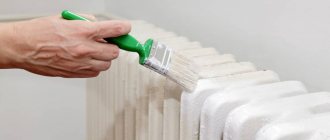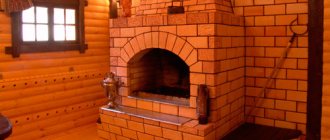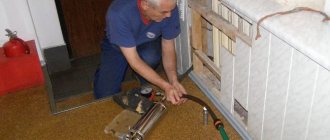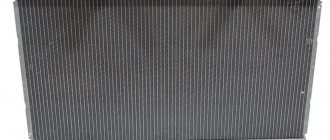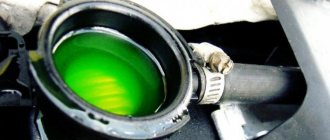
Heating radiators painting
Coloring almost always takes place in 2 layers. The application of the second coat is only possible when the first coat is dry. When painting a radiator of a complex design, it is worth using narrow brushes of various shapes.
Radiator paints
When the heating device is not out of order, but only has lost its attractive appearance, it is possible to refresh it by painting.


Painting a radiator in an apartment is not a complicated procedure. However, it requires to correctly choose a paint and varnish product for the main coating, to choose what means to paint the device. Otherwise, the upper layer of the radiator will need to be repaired again after a short period of time.


Important! When choosing paint for batteries, you need to focus on special compositions intended for heating appliances. There is an inscription on the labels, which indicates the basic information. If it is not present, you need to find the data on the thermal stability of the dye in the enclosed manual.
What criteria should be met, requirements
The paint for radiators must meet the following requirements:
- Resistant to excessive heat. The paintwork for the heating device must not change its appearance during the warranty period, even during strong heating.
- Protection against corrosion as well as rust must be provided.
- The shade of the product should not change over the life of the product.
- The paint must be resistant to abrasion. The thickness of the coating should be the same after contact with household items, furniture elements.
- Dye for heating devices should not emit substances that are harmful to health during heating.
Good adhesion to the coating. The adhesion of the dye for the battery must be high so that during use, during temperature changes, the paint for the radiators does not peel off.
A good quality radiator paint must meet the above requirements.
The choice of paint for radiators. comparison table
The workflow for painting batteries and pipes with heat-resistant compounds includes several stages:
- Preparation of the treated surface.
- Application of the coloring composition.
To carry out the work, you will need the following tools and materials:
- Brush with a metal base.
- Painting brushes - regular and radiator brushes.
- Coarse sandpaper.
- Cleaning brush.
- Spatula with metal tip.
- Metal primer.
- Battery paint.
- Degreasing or solvent composition.
https://www.youtube.com/watch?v=O2LHdXtcOh4
To carry out high-quality painting of heating devices with your own hands, it is necessary to properly prepare the surfaces. Preparatory work includes the following activities: cleaning from the old coating, removing corrosion, degreasing and priming.
- The surface is thoroughly cleaned: the old coating is removed, the places damaged by corrosion are sanded to a shine. Contamination is removed with a brush, and paint - with a spatula or special chemicals.
- After removing the paint, the surface is sanded with a brush with metal bristles, a special drill attachment or a grinder. When working with surface cleaning, personal protective equipment is used.
- The cleaned surface is sanded with sandpaper, degreased with any available solution.
- A primer with anti-corrosion properties is applied to the prepared surface for maximum protection against corrosion and to increase the adhesion of the paint composition to the base.
Most modern formulations are applied to a cold surface, therefore, the hot battery must be cooled before painting. In order to obtain a high-quality coating, it is recommended to paint the batteries, observing a certain technology.
Liquid formulations
If an oil, water, water-based and other liquid composition is used in the work, it is necessary to properly prepare the workplace and protect the surrounding surfaces with a clean cloth.
- For painting, use a brush with a curved handle or a soft sponge. The coloring agent is poured into a wide container. Hands are protected with gloves.
- The composition is applied in a thin layer to the inner surfaces and in hard-to-reach places, then the outer part of the heating device is processed. Smooth strokes are made from top to bottom, which will allow you to evenly apply the enamel to the surface.
Read next: How to choose an instantaneous water heater, which is the best brand review
Aerosol formulations
If odorless balloon paint is used for painting, then the principle of surface treatment is as follows:
- First, hard-to-reach places are processed, then the outer parts of the central and other heating elements.
- Smooth movements are performed in a zigzag pattern from top to bottom.
- The surface is processed in two layers to obtain an even coating.


If enamel for radiators is applied with a spray gun, then the principle of surface treatment is similar to balloon painting.
Before you carry out home painting of heating radiators, you should carefully study the features of the technological process, because compliance with all stages will ensure high performance and a long service life of the devices.
Silicone metal paint for battery painting.
In the production of this type of paint, silicone resin is used, mixed with organic or aqueous solvents.
The main advantages of silicone paints are exceptional thermal stability and resistance to external damage.
In addition, the paint can be applied to an almost unprepared surface.
The main disadvantage of silicone paints is the overpricing.
Types of paints for heating radiators
The aesthetics and beauty of painted heating batteries depend not only on the cost of paintwork materials, but also on the correct choice of paint in terms of chemical composition. Manufacturers of paints and varnishes produce paints on a variety of substrates. When choosing the most suitable option for a specific battery, the positive and negative characteristics of each substance must be considered.
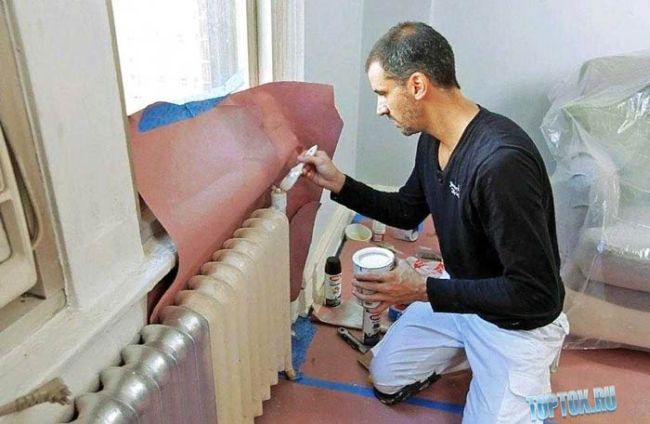

Depending on the material for the manufacture of radiators, paints are selected from the following categories:
- Oil.
- Water-based.
- Alkyd.
- Silicone.
- Powder.
For the primary layer, a glossy heating pipe paint is recommended. The subsequent re-coat should be matte in order to hide possible defects and unevenness of the metal as much as possible.
The variety of paints suitable for painting radiators is truly amazing. In addition, the products are constantly being improved, so it is recommended to study the available catalog and make the right choice.
The better to paint hot batteries
Heating devices are exposed to hot water and therefore quickly fail. Corrosion occurs on the surface of the battery.To prevent corrosion, the structure is painted with a special paint that can withstand strong temperature changes, creates a resistant film and retains its color for a long time. If the repair is done in winter, then they buy paint that does not have a strong odor.
For dyeing hot batteries, the following compositions are used:
- Alkyd. They retain their shade for a long time, do not smell and are used for interior work indoors. Alkyd dyes are considered the modern version of oil dyes and have the same curing mechanism. Such dyes are made from alkyd resins, which are produced by heat treatment of oils and polyhydric alcohols. In stores, the compositions are sold mainly in dissolved form. Depending on the type of alcohol, they are subdivided into pentaphthalic or glyphthalic. The paints are dissolved with white spirit, nefras or orthoxylene.
- Acrylic.They withstand high temperatures and are used for painting hot heating appliances. The dye is based on polymers. Paints can be water-based or varnished. To obtain the elasticity of the compositions and resistance to the environment, additives and fillers are used in their manufacture. The dyes dry quickly, have a weak odor, do not irritate the respiratory system, and it is safe to work with such formulations. These dyes do not lose their color over time, they can be used even in the kitchen, where there is often steam or temperature changes.
- Battery paint. There are acrylics that are mixed with a solvent to create a glossy finish. For staining with such compounds, a preliminary primer is not required. The layer dries quickly.
- Oil. Strong and resistant, but takes too long to dry. These dyes retain their color, but have a strong smell, so they are rarely used for work in an apartment.
Pay attention to: What is frost-resistant facade paint
In addition, the battery can be painted with aerosol cans with automotive enamel. This method saves composition and facilitates work.
Painting radiators with oil paint.
All oil paints are based on organic oils. Not so long ago, this type of paint was the only one used for painting radiators. Of the main advantages of this type of paints, it is worth noting the low cost and the created dense layer that is resistant to mechanical and temperature influences. Among the disadvantages are the following:
Unpleasant odor during staining, which can only be eliminated by prolonged ventilation. In addition, a specific odor may occur when the battery is overheated.
Oil paint creates a thick layer that prevents normal heat transfer of the radiator.
It is quite difficult to apply the coloring composition in an even layer.
In the course of long-term use, the paint may begin to crack.
With prolonged use, the paint starts to fade.
Oil paints do not provide sufficient protection against corrosion.
The longest complete drying time among all alternatives.
How to paint a heating battery: a step-by-step technology for painting radiators
Over time, old batteries lose their aesthetic appearance, rust appears, cracks appear on the coating, paint peels off. Agree, changing the radiator in this case is not a good idea. It is much easier, faster and more economical to re-paint the battery. Moreover, it is quite easy to update the appearance of the heater.
We will help you in choosing the right enamel composition, explain how to prepare and how to paint the radiator correctly. We also outline the nuances that should be taken into account when working with different types of radiators.
The proposed photo ideas will inspire you to choose an interesting solution and implement a design idea.
The need to paint the heating radiator
As a rule, if such a procedure is planned as painting cast-iron radiators for heating or other heating devices, then experts recommend doing this in two cases:
- If the paint on old batteries of their cast iron is completely burnt out or partially peeled off.
- Provided that outdated convectors are installed in the heating system in the form of a riser with several plates with fins.
If we talk about the second case, then here you need to remember that only a decorative protective surface should be painted, as well as a swinging flap. Processing of fins is also allowed, however, in this case, the convector must be completely immersed in the dye composition.
It is strongly not recommended to paint heating radiators of modern manufacturing technologies like aluminum models. This will only cause a decrease in the heat transfer of the device and significantly spoil its appearance, since it will not be possible to apply an even coating layer.
It is best to paint plate-type batteries, as well as those models with a large surface area, on the floor, while it is recommended to hold the product horizontally. In this case, the main tool for spraying paint should be a can or a spray bottle, since only then the paint layer will lie as evenly as possible (about
Training
Carefully inspect the heating system for any emergency taps. If any were found, check the performance - it is easier to paint a cold radiator. Even if it was not possible to disconnect, it does not matter: it will just take more time.
Clean the surface from dirt, grease and loose layers of the old coating. Sand thoroughly with coarse sandpaper. Then repeat the fine-grained action. If necessary, putty the chips.
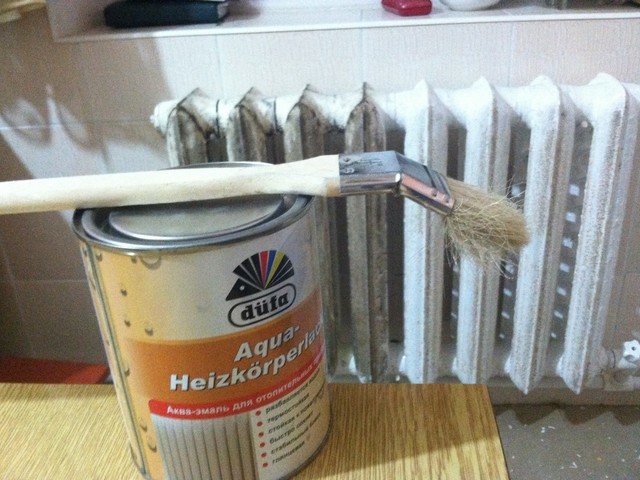

Armed with a rag, oilcloth or cardboard, protect the surfaces adjacent to the battery from accidental paint splashes.
Calculation of the amount of paint
Another important point before purchasing a dye for radiators will be the correct calculation of the staining of batteries. You need to know:
- Coating area to be painted.
- Consumption of a specific dye per 1 sq. m radiator.


The normative expenditure of funds for a heater of a specific brand will be prompted by the information that is indicated on the dye packaging.
For an accurate calculation, you need to know the number of sections in each battery and the painting area of 1 section. The area of 1 section of a specific device has already been calculated by its developer. It remains only to find this data in the documentation for the battery and multiply this indicator by the number of sections.
Preparatory work
It is necessary to prepare the surface for painting in advance. The quality of the coating depends on this.
When preparing a radiator for painting, the following works are performed:
- First, you need to clean the heater from dirt.
- The battery is then inspected for rust.
- Then, using a scraper and sandpaper, remove the old paint.
- After the surface of the battery is cleaned of the old coating, the battery is treated with a primer solution.
- Then a primer is applied, this will level the coating, remove irregularities, and ensure adhesion of paint to the surface.
- The primer is chosen depending on the type of paint.
- The place of work is covered with cellophane, and both the floor and the wall should be closed.
The main difficulty of the preparatory stage is the removal of old paint. There are several methods for removing old coatings. The most accessible is the chemical method.
To prepare a chemical composition for paint removal, you need to prepare:
- 1 kg of calcined salt;
- 1 kg of lime;
- 5 liters of water.


The washing solution is applied to the heating device, kept for 5-10 minutes, and then the paint is removed with a scraper.
The washing solution is prepared as follows: hot water is poured into a container with a volume of 10 liters, soda is added, stirred, lime is added in small portions, the solution is stirred and the mixture is infused for 10-15 minutes. This solution is applied to a heating device, kept for 5-10 minutes, and then the paint is removed with a scraper.
Pay attention to: How to properly paint plastic bottles?
The mechanical method of removing paint from a radiator is based on the use of a drill with a nozzle. During work, you do not need to press hard, so as not to spoil the metal. When the preparatory work is completed, they start painting.
Paintwork requirements
There is not always a material, and in many cases, a technical opportunity to supply a new radiator. It is easier to refresh the outside of the heating device if it is still capable of serving. In the event that the battery has already had to be repaired or it does not heat well, then it is better to replace it with a new one.
The painting process as such is not particularly difficult, but this does not mean that you can buy any composition and immediately start restoring the attractiveness of the radiator.
The paint must be selected according to certain parameters, and the battery must be carefully prepared. If this is not done, then the new coating will not last long, and soon you will have to repeat the process again.
When choosing a composition, it is best to dwell on options specifically designed for heating devices. But if there is no such inscription on the label, you should carefully study the instructions and find data on its heat resistance.
Paintwork requirements:
- Heat resistance. The composition applied to the radiator case must withstand temperatures up to 80-90 degrees and be flawless during the time promised by the manufacturer.
- Adhesion. It is necessary that the composition has good adhesion to the painted surface. Does not flake off when heated and alternately heated / cooled.
- Corrosion protection. The composition must contain anticorrosive substances so that the coating in contact with the body does not cause its destruction.
- Color fastness. An unconditional condition, since radiators are painted for aesthetic purposes, among other reasons.
- Abrasion resistance. From direct contact with a variety of furnishings, items to dry, etc. the coating should not become thinner.
- Security. It is very important that there are no components harmful to health in the composition.
A good radiator paint should meet all the requirements, and not individual points.
The choice of paint for pipes
The white cast iron radiator is a classic version of the heater located under the window. Painting in the color of a white window sill and window frames is the simplest and most affordable solution.
Batteries presented in black and brown colors are becoming quite popular. There is an opinion that a battery painted in a dark color heats up faster and gives off heat longer. Batteries in dark color will be appropriate in industrial-style interiors.
The most successful and original solution for country houses and apartments is batteries painted in the color of the walls. Such a move does not require complete hiding or masking of the elements of the heating system. All that is needed is to successfully fit the heating devices into the overall style of the room.
Many homeowners decide to take a more daring step - to paint the batteries in a color that contrasts with the walls. This design option will be relevant for the interior in the style of minimalism, modernism, colonial, rustic and art deco.
The original version of coloring the battery using gradients or the ombre technique.For the outer section, a neutral color is chosen, each subsequent one becomes brighter and more saturated with the addition of light graduated shades.
Painting heating radiators in different colors is a good solution for children's bedrooms and playrooms. Here you can embody the most unexpected ideas: apply patterns, drawings and painting. Decorate batteries beautifully as rainbows, colored pencils or fairy tale characters.
| Types of paintwork materials (paints and varnishes) | Types of surfaces | Benefits of paints | Disadvantages of paints |
| Oil paints | Cast iron | Affordable cost, wide range of colors | Long drying time, strong odor, susceptibility to yellowing, cracking and chipping |
| Acrylic enamels | Cast iron, steel, bimetallic | Virtually no pungent odor, high drying rate, attractive glossy shine, rich color gamut | High demands on the surface to be treated: thorough cleaning and pre-priming |
| Water based alkyd enamels | Cast iron, steel, bimetallic | Subtle chemical odor, color fastness | The presence of titanium white for resistance to high temperatures, which increases the cost of production |
| Solvent-based alkyd enamels (organic) | Cast iron, steel, bimetallic | Withstand high temperatures, wide color gamut, affordable cost | Persistent chemical odor, tendency to yellowing |
| Alkyd hammer enamels | Cast iron, steel, bimetallic | High protection of surfaces from damage, resistance to high temperatures, durability, affordable cost | The presence of a mild chemical odor that disappears upon drying |
| Powder paints | Cast iron, steel, bimetallic | High strength and durability, resistance to temperature effects | The powder composition is applied by professional equipment in a special chamber |
| Silicone paints | Cast iron | Increased heat resistance, durability, wear resistance | High cost, pungent odor |
| Water-based paints | All kinds | No pungent odor, wide range of colors, high environmental friendliness and safety | High requirements for surface preparation - obligatory degreasing and priming |
| Serebryanka | Cast iron | High temperature resistance, low cost | Persistent chemical odor |
| Aerosol paints | All kinds | Wide range of colors, ease of application, affordable cost | Bad smell |
Read more: Which heating radiators are better which battery to choose and why
The answer to the question: is it possible to paint hot pipes - has already been provided, so we proceed to the selection of the dye. Today there are several types of paint that are a priori suitable for processing hot radiators.
- alkyd enamel - the surface treated with this material can be matte or glossy. The paint creates a durable finish. Among the variety of these dyes, there is a special one for radiators that can be applied to hot pipes. In addition, the enamel will create a barrier against rust formation;
- acrylic paint - has proven itself well at home, as it is easy to use and does not emit odor when dried due to the fact that it is created on a water basis;
- oil paint - this material is hopelessly outdated due to its characteristics (it dries for a long time, has a pungent smell), so we will not consider it;
- spray paint - suitable for use in an industrial environment, requires special application skills. This material is not suitable for use in the home;
- silicone-based dye - due to the cost and specifics of the application, such a paint is significantly inferior to the first two options;
- a dye based on heat-resistant varnish - great for heated pipes, but in a city apartment and a private house, the temperature of the radiator is unlikely to rise above 90 degrees, so it is inappropriate to use such a dye;
- water-based dispersion paint - dries quickly on a heated surface, which interferes with high-quality film formation. Moreover, such a dye already has poor abrasion resistance - it is not suitable.
Of all these paints, alkyd enamel and acrylic paint have proven themselves in the best way. But they have two drawbacks: alkyd enamel - exudes a smell, and acrylic - will not protect against rust. In order not to tolerate an unpleasant smell from alkyd paint, you can use acrylic, but before that you need to apply a layer of primer to the batteries. Such paint for hot heating pipes holds up pretty well and does not darken over time.


Examples of enamels for painting radiators
Among the range of special radiator paints, there are options that are better suited than others. For example, among alkyd enamels, Swedish paint "Elementfard Alkyd" surpasses its competitors in its characteristics (it emits very little odor, dries quickly, is used at surface temperatures up to 100 degrees, does not require priming).
Read more: Classification and labeling of steel pipe fittings
Painting process technology
Now let's look at how to paint a radiator to achieve a good result. This must be done with the heating turned off, otherwise, in some areas, the paint will dry out too quickly, lie in an uneven layer, and smudges that look ugly are formed. Of course, there is a special paint on sale intended for use on hot radiators, but it can also lie unevenly if the heating is not turned off.


Currently, heating batteries are painted in colors that best suit the overall interior design of the room.
If there is no other way out and you have to paint the heater during the heating period, then you need to at least shut off the hot water supply yourself or contact the housing office with this request. In this case, the temperature on the radiator will drop significantly.
So, if you have already decided which paint is best to paint radiators, you can proceed directly to the painting process:
- First of all, you need to take care of protecting the floor from paint stains. To do this, lay waste paper or cloth under the batteries.
- Choose small, soft-bristled brushes, one straight and the other curved to paint hard-to-reach areas.
- Apply paint first at the top of the battery and move towards the bottom. The battery is painted from all sides: first the inner overlap, then the outer, to avoid staining the hands and clothes. After the first layer of paint has dried, the second is applied. It is necessary to remember the rule that two thin layers are better for paint than one thick one. Indeed, only in the first case a uniform and smooth paint coating will be guaranteed.
The radiator can also be painted with a spray gun or from a spray can.


Painting the heating battery with heat-resistant paint from a spray can - convenient and quick, while the paint lays down in a thin even layer
When using a spray gun, it is recommended to remove the battery so that you can paint all hard-to-reach areas. Painting with a spray can filled with heat-resistant paint is performed very quickly and efficiently. Usually, detailed instructions for painting surfaces with a spray can is given on its packaging. The basic rule: performing zigzag movements from top to bottom at a distance of about 30 cm from the surface to be painted.
Before painting radiators, it is important to study the technology of this process, because its observance will ensure an attractive appearance of the heater and its reliability.
Painting instructions
Staining rules:
- First you need to check that the floor and walls are closed from the ingress of dye.
- If necessary, add additional cellophane.
- First, you need to study the instructions for the coloring composition, stir the mixture to get a uniform consistency.
- Start staining from hard-to-reach areas. For this, narrow brushes with a curved handle are used.
- The outer part of the battery is painted with a roller or a wide brush.
- You need to paint from top to bottom, so there will be no smudges and the composition will not be sprayed to the sides.
- To get a high-quality finish, you need to apply 2 coats of paint.
- The second layer should be applied only after the previous one is completely dry.


6 tips for painting hot radiators.
If painting is done with an aerosol can, then the paint should be sprayed from a distance of 30 cm.... After staining the battery, you need to ventilate the room. If these requirements are met, then the radiator can be painted when the heating is on.
Rules to consider when painting hot batteries:
- Paint drips should not form on the surface of the heating device during painting. To do this, apply the product in a thin layer.
- The back of the radiator can be painted with a curved brush, or if not, you can use a toothbrush.
- If it is decided to clean the warm battery in the room by a chemical method, then you need to wear protective gloves and clothing so that the chemicals do not get on the skin. A respirator can be used to protect the respiratory system.
- After the radiator is painted, it is imperative to ventilate the room. The best option would be to use odorless acrylic paints or special dyes produced for coloring heating batteries.
- Concealed parts and heating pipes do not need to be painted, as this will maintain better heat dissipation.
- Before purchasing a paint and varnish composition, you should carefully read the instructions for applying the dye.
Pay attention to: How to dye heels at home
Central heating batteries can be painted hot in winter during the heating season. Modern compounds can withstand high temperatures and do not lose strength characteristics. If you follow all the recommendations when preparing heating devices and performing work on painting hot batteries, then the coating will be durable.
Read on:
Painting cast-iron radiators: surface preparation, choice of paint and varnish material, step-by-step instructions for painting
Paints for heating radiators: types and varieties of compositions, popular brands of paints
High-quality painting of heating radiators with powder paint with hot polymerization
Heating pipes painting: how and with what to paint, step by step instructions.
Radiator paint
What battery paint is better to buy
After reading the rating article, it becomes clear that radiators cannot be painted with the first paint they come across. Heat-resistant coatings must be used for heating pipes and radiators.
In order not to be mistaken in the correct choice of paint and varnish material suitable for specific conditions, you need to familiarize yourself with the labeling and chemical composition of the selected product. What paint for pipes and radiators is best suited for a given room, the landlord decides. At the same time, it does not hurt to familiarize yourself with the recommendations of experienced specialists and user reviews.
What paint to choose
Radiators corrode as they are exposed to temperature extremes. For their coloring, the following compositions are used:
- Acrylic... They are able to withstand high temperatures, so the paint lasts for a long time.
- Alkyd. These are oil-based dyes used for interior decoration.
- Battery paints and varnishes... Acrylic based compounds mixed with solvents. There is no need to prime the surface before painting.
- Oil. They are durable and resistant, but take a long time to dry and smell strong.
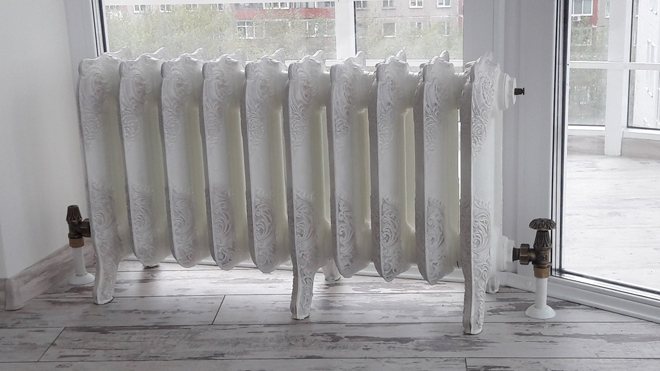

Attention. It is convenient and easy to paint the radiator with automotive enamel from a spray can.
Heat-resistant acrylic enamel paint.
The most acceptable option for painting parts of the heating system is acrylic enamel.
When painting, the coloring composition creates a smooth and even layer.
Also, acrylic enamel is almost odorless during painting. After it dries, the smell is also absent.
When choosing an enamel, you should take the types that have a heat resistance of more than 80 degrees (Not all enamels meet this requirement).
In addition to all other advantages, the first layer of acrylic enamel dries up within an hour and a half. The second layer of enamel usually dries in about 5 hours.
The main disadvantage of acrylic enamels is low resistance to mechanical damage.
Acrylic enamel
The main advantage of acrylic enamel is very high heat resistance to yellowing, it is 100 ° С, in some - up to 120 ° С; at home, it will not turn yellow, since heating radiators simply do not heat up to such temperatures. Their main operating mode is 40-60 ° C. Also, this enamel is considered quite durable, which allows you to preserve the decorative appearance of the painted device for a long time. A plus in the piggy bank of the positive characteristics of the acrylic coating is the rather quick drying of the applied layer, 2-3 hours. More accurate information is usually indicated on the paint can.
Some are interested in the question of whether it is possible to paint hot batteries. Answer: acrylic paint can be used to paint even warm radiators.


The peculiarity of these enamels is that they are produced on organic solvents. So in the process of coloring, a faint characteristic smell of a solvent is released, which, however, evaporates quite quickly. However, thanks to this component, the paint acquires a beautiful glossy shine when it dries. But, when dry, the color scheme may slightly change the shade. Usually acrylic darkens as it dries. This enamel has excellent mechanical resistance, UV resistance and does not allow steam to pass through. In addition, they are endowed with water repellency and are resistant to cold once completely cured.
In addition to glossy, there are matte and semi-matt acrylic products.
They are diluted with water, but when dried, as the names suggest, they do not acquire a characteristic shine. Often these products are more expensive than glossy enamel, but they better hide dents and other small surface defects that appear when coated with glossy paint. It takes about 10 hours for a battery painted with an acrylic emulsion to dry completely.
So if you decide to paint the batteries with acrylic paint, choose which option works best and paint.
Heating battery paint. Criterias of choice.
All dyes used for painting elements of the heating system differ in their physical and technical parameters from ordinary paints and must fulfill certain requirements:
- One of the main requirements is the absence of harmful chemical fumes under the influence of elevated temperatures. Each package must be marked with the standards that the paint corresponds to. From Russian manufacturers - the norms of the current GOST. From imported manufacturers - European standards.In the absence of this marking, it is better to refuse to purchase the product, in order to avoid harmful consequences.
- The thermal stability of the purchased product must be more than 80 degrees. Otherwise, the paint will begin to crack and flake off.
- If possible, a quick-drying compound should be purchased to speed up the painting process.
- The paint must be corrosion resistant. This will increase the life of the entire radiator.
- Some types of paints have an unpleasant odor until they dry completely. This should be taken into account when painting residential premises. It is best to treat rooms that can be well ventilated with these types of paints.
- The paint must be moisture resistant for wet cleaning the radiator.
- High heat transfer for smooth battery operation.
How to choose the right paint and paint the radiator
Heating batteries are an invisible element of our home and harmoniously fit into its interior if they are new, shining with fresh paint. But if the batteries are already old, the paint on them has faded and swollen, then in this state they are striking and are unlikely to decorate the house. The problem can be solved by replacing the batteries. But this is expensive and not always justified, so there is another way out - to paint the batteries again. For this purpose, a special paint for heating radiators is used. Its purpose is to protect the surface of batteries from corrosion, give them the desired color, as well as a decent appearance. And if earlier pipelines were painted only white, now they are painted in the color that best suits the design of the room. Our article will discuss how to choose a paint for heating radiators and how to paint them correctly.

